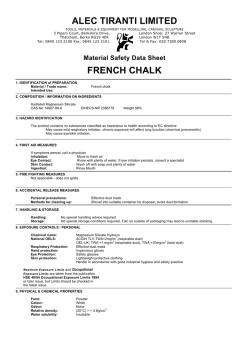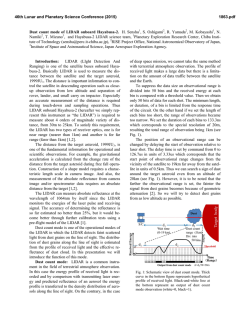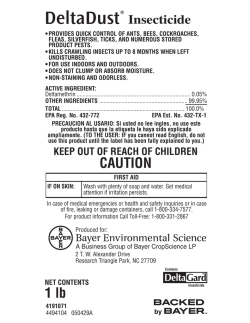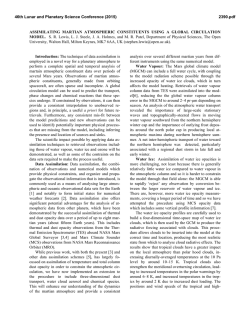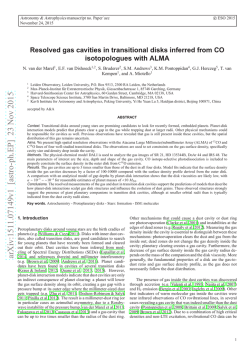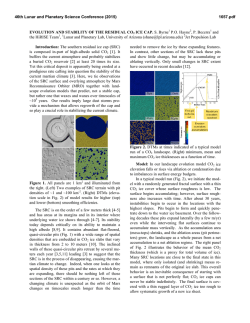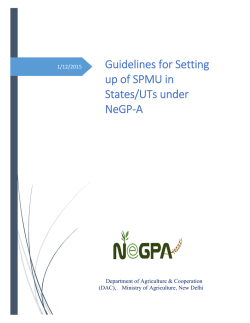
Dust Measurements by the Student Dust Counter Onboard the New
46th Lunar and Planetary Science Conference (2015) 1701.pdf DUST MEASUREMENTS BY THE STUDENT DUST COUNTER ONBOARD THE NEW HORIZONS MISSION TO PLUTO, , J. Szalay, M. Piquette, M. Horanyi, Laboratory for Atmospheric and Space Physics, U. of Colorado, Boulder, CO 80303, USA, ([email protected]). Flux [10-4 m-2 s-1] Introduction. The Venetia Burney Student Dust SDC observations. The SDC measured denCounter (SDC) is an impact dust detector on board the sities, converted from fluxes measured outside the orNew Horizons Mission to Pluto. SDC is capable to bit of Jupiter through to the time of this analysis at ≈30 resolve the mass of dust grains in the range of 10-12 < AU, are shown in Figure 2. Combining interplanetary m < 10-9 g, covering an approximate size range of 0.5 − dust grain measurements by SDC with a dynamical 10 µm in particle radius [1]. The measurements can be dust grain trajectory tracing code provided an estimate directly compared to theoretical predictions of grain for he mass production rate M = (8.9 ± 0.5) × 105 g/s trajectory tracing models of dust originating from and power law index of the initial size distribution α = Edgeworth-Kuiper Belt (EKB). Through the end of -3.02 ± 0.04 of dust in the EKB. [3]. This talk will 2014, the New Horizons spacecraft reached beyond 30 share the latest available SDC data. AU, enabling SDC to map the dust density distribution Year across the solar system. SDC will continue to measure 2009 2012 2015 10 dust as it transits through the Edgeworth - Kuiper belt. SDC is the only experiment to date that was designed, built, and is now operated by students on a 8 deep space mission. It has provided an unparalleled opportunity for about 25 students to learn about space 6 instrumentation. SDC continues to involve an ever changing smaller group of 3 students who operate the instrument and analyze the data, handing over their 4 responsibility to the next ‘generation’ every few years. SDC could not have been built without the support of 2 the late Dr. Tony Tuzzolino who first designed these types of instruments. 0 The SDC instrument. The instrument (Figure 1) 5 10 15 20 25 30 35 consists of a set of polyvinylidene fluoride (PVDF) Heliocentric Distance [AU] film impact sensors, carried on a detector support panFigure 2. SDC measurements of the dust flux (m > 10-12g) el, which is mounted on the exterior of the New Horithrough the end of 2014. zons spacecraft. It is outside the spacecraft multi-layer insulating blanket, facing the ram direction. Signals Based on in-flight tests and calibrations, and the scifrom the sensors are collected through an intra-harness ence data as of to date, we expect SDC to continue to that runs from the detector assembly into the spacecraft make dust measurements beyond Pluto. The Pluto eninterior to the instrument electronicsStudent boxDust mounted op-Instrument Design Counter (SDC): ! counter will take place in July 2015, at a distance of 32 posite the detector panel. AU from the Sun. New Horizons is expected to remain Key Properties Active Area of 0.1 m functional and operate for decades to come, fully Consists of Three Assemblies: reaching deep into the Edgeworth - Kuiper belt. SDC 1. Detector Assembly (18’’will x 12’’) continue to provide insight about the dust produc2. Electronics Box ! (5.4’’x8.25’’x1.825’’) tion at the outskirts of our Solar system and enable ! 3. Intra-Harness ! comparisons with dust disks around other stars. ´ J. R. SZALAY, M. PIQUETTE, AND M. HORANYI: THE STUDENT DUST COUNTER 3 2 DSC03438.JPG Cost: $1.6 M! Mass: 1.6 kg" Power: 5 w" Mihaly Horanyi Page 17 Figure 1. Photo of the SDC during thermal testing (left), and the schematics of the instrument (right). !!!!!!!!!!!!!!!!!!!!Cosmic!Dust,!Kobe!8010,!2012! Fig. 1. SDC during thermal testing (left), and the schematic drawing of the experiment (right). Two additional sensor patches (not shown) are attached ! to the backside of the detector assembly to monitor noise events. SDC ⇠0.1 m2 of sensitive area. It was designed to measure the mass of IDPs in the ! their mass. The instrument weighs 1.6 kg range of 10 12 to 10 9 g. Impacts of bigger dust particles are registered the without the ability to determine and consumes 5.1 watts of average power. References: [1] S. A. Stern, Space Sci. Rev., 140, 3 (2008). [2] M. Horanyi, et al., Space Sci. Rev., 140:387 (2008). [3] D. Han, et al., Geophys. Res. Lett., 38:L24102 (2011).
© Copyright 2025

